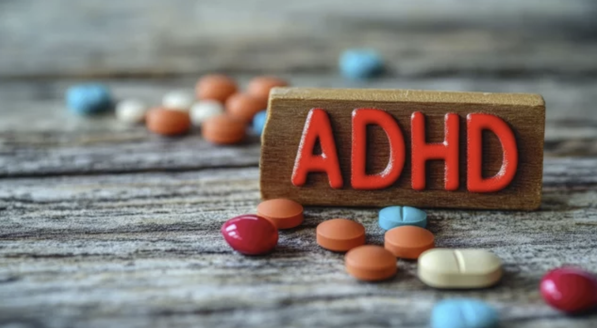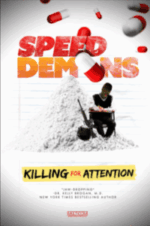
Avoid ADHD Meds at All Costs
My friend’s 20-year-old daughter was sent to jail last week for her connection to a drug-dealing operation involving meth. She comes from a stable Christian family and was raised in the church. But at age 6 she was put on ADHD medication (Concerta) to address her impulsivity and inability to focus on her school work. Her parents took her off it in less than a year finding natural methods that healed her gut and her body, alleviating symptoms. However, the changes to her brain had already been made during those critical developmental years likely seeding her future addiction.
Two weeks ago, I was at the wonderful Childrens Health Defense Conference in Austin and sat with Bob Schwartz at dinner. Bob is a former executive in Corporate America with a happy family, now living alone barely making a living, due to the sample of Concerta he took for just 5-days 20 years ago which caused a psychotic break-down. You can watch the 30-minute documentary Bob has made to warn other people of the risks of these dangerous pharmaceuticals which include Ritalin, Adderall, and Vyvanse.
Natural approaches to address ADHD symptoms work with the body leading to an improvement in overall health. Do not be persuaded to try the quick-fix pushed by doctors and Big Pharma – it is simply playing Russian roulette with your life or that of your family member.
Symptoms of ADHD
Attention Deficit Hyperactivity Disorder is nowadays used to refer to a broader category of symptoms that Dr Daniel Amen in his useful book Healing ADD divides into 7 distinct groups. In earlier versions of the DSM (Diagnostic and Statistical Manual of the American Psychiatric Association) it was referred to as ADD with or without hyperactivity, and before that, hyperkinetic reaction of childhood.
Read my earlier article on Re-thinking the Mental Health Crisis for my thoughts on doctors’ reliance on the DSM to label people.
The common symptoms being experienced tend to include:
Short attention span for routine tasks
Distractibility
Difficulty staying organized
Lack of follow-through, and
Poor internal supervision or judgement sometimes referred to as impulsivity.
Most 2 or 3 year olds would fit this description. It’s simply a lack of brain development. In an older child, or even an adult, these symptoms should be viewed as brain ill-health with a focus on getting to the root cause rather than medicating.
An Increasingly Common Diagnosis
My older son was diagnosed with ADHD and Aspergers at aged 5 and the recommendation was stimulant medications like these. I refused.
We employed various healing strategies to help my son and 15 years later he is on the Dean’s list at a major University completing his Junior year in mechanical and aerospace engineering, leading a team competing in Baja off-roading competitions and deepening his relationship with his girlfriend of two years. He takes no medications and has learned how to keep himself healthy with wholesome food and quality supplements.
According to an IQVIA report, the number of stimulant prescriptions for ADHD increased by 60% from 50 million in 2012 to 81 million in 2023. This included over 16 million patients. The numbers are staggering, and it is not just a US problem. Prescriptions for these drugs are skyrocketing around the world.
While I am not discounting the severity of some of the symptoms that can interfere with life and learning, it is the root cause we must address – these psychostimulant medications are only adding to the problem.
Insidious Risks of Medicating
Amphetamines have a long and sordid history. Big Pharma first found a market for them in the 1950s to cure everything from nasal congestion to obesity, anxiety and depression. The United Nations now estimates there are 34 million amphetamine users globally and another twenty million using “ecstasy-type” drugs (another stimulant).
Meth addiction destroys your health including weight loss, brain damage, organ damage, and severe tooth decay with users exhibiting irritability, paranoia, hyper-activity, increased aggression, and depression to name a few.
Many amphetamine drugs were banned in the 1970s, particularly for weight-loss, so Big Pharma had to find another market. Enter some hyperactive kids now labelled with ADHD, and more recently, adults manifesting similar symptoms due to poor lifestyle and brain ill-health.
While marketed as safer formulations, the side effects listed on the package inserts of these ADHD medications still include: appetite loss, insomnia, irritability, hallucinations, depression, and even suicidal ideation.
Addiction is a very real problem as told through a NY Times article of the life and death of former aspiring medical student Richard Fee who started taking Adderall in college to help him cram for exams and ended up taking his own life.
 The documentary Speed Demons: Killing for Attention is a sobering look at first how a former honors student with a respected legal career suddenly became a mass shooter. It then delves into various other well-known mass shootings and murders across the US. In all instances recent prescriptions of these ADHD drugs were implicated.
The documentary Speed Demons: Killing for Attention is a sobering look at first how a former honors student with a respected legal career suddenly became a mass shooter. It then delves into various other well-known mass shootings and murders across the US. In all instances recent prescriptions of these ADHD drugs were implicated.
Doctors will try to explain that adverse effects are rare and that the benefits of these medications outweigh the risks. But artificially tinkering with a brain’s dopamine and norepinephrine pathways, which have been shown to affect serotonin production and the glutamate and opioid systems, is a recipe for disaster with permanent changes in the brain a likely reality.
Strategies to Try First
Critical to a body and brain working well is to eat wholesome food free of toxic ingredients such as sugar and chemical additives in processed food. Focus on organic pasture-raised proteins and good fats like avocados and nuts. Your brain also needs short-chain-fatty-acids like acetate and butyrate which are produced when the good bacteria in your gut digests the fiber in plants. So add plenty of organic greens and fresh fruits and vegetables.
However clean your diet, if your brain is not working well it is likely to be suffering from nutrient deficiencies and supplements will be needed for additional support. Linus Pauling coined the term Orthomolecular Psychiatry and explained that the brain is more sensitive to deficiencies in vital nutrients than any other organ in the body. A high quality vitamin B-complex and probiotics are probably the place to start. I also like to recommend Empower Plus which my son still relies on and we credit for the positive change in the trajectory of his life. It is a proprietary blend of vitamins and minerals, formulated for brain health and maximum absorption with a ton of research behind it.
Physical exercise has been shown to spur the generation of new brain cells and increase blood flow to the brain. Exercise has also been shown to increase the amount of neurotransmitters available to the brain. It has long been known that children perform better when participating in daily exercise. Sedentary lifestyles have a lot to answer for today’s skyrocketing ADHD diagnoses. Just about any way of moving your body will help but exercise that involves straining your muscles will be especially beneficial. When my son was in elementary school his teachers would give him a pile of heavy books to take to the office when he got especially fidgety. In later years he became a gym rat which helped immensely.
Sleep deserves way more respect than we’re giving it. The processes that occur in our brains and our bodies when we sleep are nothing short of magical. Adults need 7-8 hours solid sleep every day of the week. Children need 10-12 hours depending on their age. Fixing this critical aspect of our lifestyle can produce incredible alleviation of symptoms all on its own. It is a tough battle to fight with teenagers as their circadian rhythms naturally have them awake late into the night with a requirement to get up early for school. But the more you can encourage sleep to be prioritized the better the outcome. In our house the internet goes off at 11pm. In college my son was able to schedule later classes and as he’s matured he’s got himself to bed earlier.
Just one of several natural interventions available these days for treating mental health problems without medications. Neurofeedback is a non-invasive, interactive treatment that allows patients to retrain (and effectively rewire) their brains to enhance emotional, behavioral and cognitive health. My son underwent neurofeedback for over a year when he was 7-8. The improvements month to month were striking with the initial treatments concentrated on his hyperactivity and focus with later treatments dedicated to improving his social skills.
For more detail on these strategies and many more for mental health more broadly, read Chapter 8 of my book, How to Be a Healthy Human; What Your Doctor Doesn’t Know About Health and Longevity.



